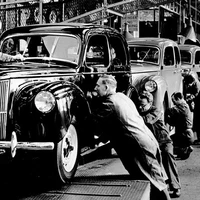Theory and practice of organizational behavior bring us many promising concepts and skills: Coaching, transactional analysis, one-minute management, self-managing teams, authentic self-presentation, 360° feed-back, etc.. Also a wide arsenal of skill-training has been developed: Problem solving, feed-back skills, decision making, negotiating, effective leadership; to name only a few.
In all these areas the handling of emotions seems rather neglected. I will describe how a few centuries ago emotions in the workplace were much more visible. People experienced great difficulties in coping with fierce even outrageous impulses. We have tamed these impulses. But they are still of critical importance for organizational behavior. Moreover our manners and standards of emotion management show a close relation with patterns of power and dependency. This is another neglected area for authors and trainers concerned with skill-training. How realistic are the insights of organizational behavior when neglecting the overriding importance of power relations? How helpful is modern skill-training in its disregard of emotional drives, power differences and dependency relations? I will explore these questions by applying a historical perspective.
In this article I will describe how over the past 600 years behavioral standards in the West have changed in close relation to changing patterns of power and dependency. In doing so I am building on the work of Elias (1939) and Wouters (1990). One characteristic of this development is the increasing control and curbing of emotions. Another more recent characteristic concerns the process of informalization.
This contribution starts with the behavior in meetings of rulers and authorities in the Middle Ages. In part 2 Emotion management, status competition and powerplay I will address behavior in modern organizations. Both parts will conclude with some suggestions to improve our understanding of behavior in the workplace.
Struggling with violence
The Dutch historian Huizinga (1924) writes about the more ferocious and rather unpredictable shifts of behavior in medieval Europe. There undoubtedly were norms and agreements to regulate mutual interaction, but “time after time the fierce roughness breaks through the embellished forms”.
“At the coronation banquet of Charles VI, in 1380, the Duke of Burgundy seeks, by force, to take the place to which he is entitled, as doyen of the peers, between the king and the Duke of Anjou. Already the train of the Duke begins to thrust aside their opponents; threatening cries arise, a scuffle is breaking out when the king prevents it, by doing justice to the claims of the Duke of Burgundy” (Huizinga, 1924, p. 38, 39).
According to an observer at the peace conference at Atrecht in 1435, the participants “throw themselves on the ground, sobbing and groaning”. The relatively refined life at the court is characterized as “continual noise and disorder, swearing and quarrels, jealousies and injuries, in short, the court is an abyss of sins, the gate of hell”. A ferocious fight can erupt at any time over anything, whether it be a game of chess or a ceremonial funeral.
Even-temperedness
To my knowledge, the earliest publication in Europe to propagate other rules of conduct among authorities is a treatise by Bernard du Rosier (1404-1475), also known in his days by the more commonly used Latin name Bernardus de Rosergio. His treatise was written at the court of the King of Castile. Central to the text is ‘equanimitas’ - even-temperedness. What does it refer to? Well, as the term itself suggests, it refers to keeping emotions under control continuously. Two examples:
“... although offended, surmount these injuries of the heart and rise up to the most exalted attitude ... suppress emotions and show oneself in command” (Rosier, chapter 15, p. 15, 16).
“Let outrage yield to friendliness, impetuosity to wisdom, rigidity to adaptability and curtness to approachability. Remain distinguished and unmoved to those whose responses are less pleasant or negative, .........” (Rosier, chapter 20, p. 20).
Rosier keeps on repeating the necessity to temper and control all kinds of apparently normal and powerful affects. For example:
- being inflated with supercilious, conceited arrogance
- tyrannical behavior, clinging to greed
- brazen and presumptuous forcing one’s own way
- mocking religious matters
- committing foul acts, being choleric or malicious
- pursuing fame based on vanities. (Rosier, chapter 2, p. 5)
Recent advice for administrators and managers lacks such colourful references to untamed behavior. In our days containment of these strivings is obviously more matter-of-course.
Restraint en regulation
Despite of periods of stagnation, behavior at the European courts gradually became more restrained and refined. Also, next to the courtly military-aristocratic elites, merchant and artisan guilds, predecessors of modern work-organizations emerged which tried to regulate interaction. In the 15th and 16th century guild regulations we find the precursors of current meeting procedures. The bakers’ apprentices guild’s register of 1404 states: “Someone who uses violence, spills beer or utters offensive language, will be fined ...”. (Van Vree, 1994, p.298).
These regulations describe in detail what is not allowed: swearing, breaking glassware, delivering blows, attacking someone with knife drawn. Furthermore, one must be on time and wear decent clothing. The fines imposed to enforce this behavior were considerable. In 1457 the guilds-dominated town council of Utrecht in the Netherlands even issued a regulation that addressing other issues than those on the agenda during a meeting was punishable by death (Van Vree 1994, p. 58).
Early capitalism and increasing discipline
In our first industrial organizations only the company-owners and their immediate environment had been part of the development described above. The workers had to be coerced to toe the line through rules that closely resemble those in the 15th century guild registers. In his description of the emergence of the factory regime in the 19th century, Van Iterson (1992, p.82) wrote:
“The problems for the manufacturers were first of all problems of discipline and coordination. Factory regimes are based on a tangled combination of i) coercion (from the side of the manufacturers) and ii) willingness or motivation (on the workers’ part).”
The discipline which seems so natural to us now, was not in evidence then:
“Bringing together men, women and children in one space implied the danger that people would get in each other’s way, that arguments could erupt, sexual relations engaged in, or that they would ‘overindulge’ in other activities which were considered debauched (drinking) or idle (games).
Labourers also had to learn to control their language: subversive and obscene utterances also posed a threat to orderly labour and they were fined heavily. The same dangers also existed outside the factory, especially in combination with alcohol consumption. So conformance with the industrial regime was indirectly threatened by ‘corruption of the morals’ in their free time.” (Van Iterson, 1992, p. 83-84)
This can be illustrated by the case of the earthenware industry of Josiah Wedgwood (1730-1790), a liberal reformer in public affairs and a patriarchical factory owner in eighteenth century England. During his lifetime he transformed a local pottery, with a dozen men at work, into an international firm.
Waste and idleness
Wedgwood had to fight a long local tradition of ‘customs in common’, in particular the ‘stoppages for Wakes’, (a local annual feast lasting several days and nights which were spent eating and drinking intemperately and ‘fornicating’), but he also had to combat ‘waste’, ‘idleness’, ‘the bane of drinking’, ‘working by the rule of thumb’, ‘inefficiency’, ‘arbitrariness’, ‘irregularity’ (McKendrick, 1961, p. 38).
His own personal control over his men was effective enough. But he was ‘forced with increasing frequency to leave them ‘without any head to look after them’ (McKendrick, 1961, p. 39). There was no tradition of supervision in his factory in his absence. For instance, when he put an older worker in charge, it turned out that this man lacked authority due to his familiarity with colleagues. The resulting informality ‘lapsed too easily to irregularity’. As Wedgwood describes:
“ Daniel does pretty well at work and I am here every day, but he often leaves the work and drinks two or three days together, and has no taste to direct at any time” (McKendrick, 1961, p. 39).
Supervision and regulations
Wedgwood formalized his disciplinary rules by writing them down in the Potters Instructions (1780) and in the ‘Common Place Book’. Some examples of the rules and sanctions for enhancing one’s self-control:
“Any person seen throwing within the yard of this manufactory forfits 2s.6d,..”, “any workman strikeing or otherwise abuseing an overlooker to lose his or there place..”, any workman conveying Ale or Licquor into the manufactory in working hours forfits 2s...”, “any person playing at fives against any of the walls where there are windows forfits 2s..” (McKendrick, 1961, p. 45).
The scientific method
Taylor, the founder of scientific organizational design (1856-1915), made a contribution to organizational science that fits well into this perspective. His methods were largely intended to impose discipline on the activities of subordinates, something which was sorely needed as far as Taylor was concerned. He gave many descriptions of how employees managed to restrict production by ‘soldiering or loafing’. (Taylor, 1947, pp. 19-24).
He repeatedly stated that his ‘scientific method’, using individual training, separation, special reward systems and other measures, could gradually overcome these tendencies (Taylor, 1947, pp. 32, 34, 69, 72-74). Taylor vividly described his experiences as a foreman in a steelworks:
“No one who has not had this experience can have an idea of the bitterness which is gradually developed in such a struggle .... And there are few foremen indeed who were able to stand up against the combined pressure of all the men in the shop .... If the writer had been one of the workmen, and had lived where they lived, they would have brought such social pressure to bear upon him that it would have been impossible to have stood out against them.” (Taylor, 1947, pp. 50-51).
From these tumultuous experiences Taylor distilled his, as he called it, ‘scientific management’ (Taylor, 1947, pp. 52-53). His experiences provide a good impression of how personal power can be replaced by more ‘neutral’ mechanisms of control. Despite the strong resistance Taylor encountered, his methods were introduced on a large scale. This was possible because of the much greater power of management. At the same time management was forced to exploit this power surplus due to the fierce competition with other companies.
Taylor’s own intentions were entirely different. He believed that the interests of employers and workers were essentially the same. ‘The great mental revolution which occurs under scientific management’ would do away with contention and antagonism and replace them with ‘friendly co-operation and mutual helpfulness’.
This idealistic dream could be seen as a predecessor of more recent images as 'the learning organization', 'empowerment' and 'shared values'.
Conclusions
The examples in this article illustrate the struggle to discipline and control organizational behavior. Very central is the need to tame strong emotional impulses to raise the chances on a reliable flow of products. The current high degree of self-discipline and control looks sometimes quite natural and seems self-understood. It definitely is not.
- Changing ways of emotion management as described for instance by Rosier, take many generations. Nearly three centuries after Rosier, Callières writes "show no contempt", "do not utter threats immediately", "control your temper", "It is better not to appoint gamblers and drunkards to high positions". Félice writes towards the end of the 18th century: "Men are moved by feelings alone. Master your emotions or you will be off on false adventures". (Mastenbroek, 1992 , pp 173-196). It seems as if the development was frozen for all those centuries. But despite all kinds of stagnation and counter-movements the development towards different patterns of emotion management is unmistakable. At first in small groups at the junctions of commerce and politics (Elias, 1994). Groups whose continuity sometimes lasted only a few generations before they perished in battle and confusion.
Only a long-term perspective reveals how, gradually, more and more segments of the population acquired this different psychological make-up. The pace at which this development will continue is unsure. - Standards of social skills are related to patterns of power and dependency. Many social configurations do not foster the abilities of emotion management which apply to some of our modern organizations. Current standards of social skills propagated in textbooks and training programmes have to be seen in relation to networks of dense interdependencies and rather flat power balances. These networks are to be found mainly in those parts of the West which because of their economic and political position are quite able to propagate their standards on a global level. Let us not forget that in many societies and organizations other ways of emotion management are needed simply to survive. Also within our Western societies there are many organizations resembling steep power pyramids. Workers feel very dependent on their superiors. Other behavioral rules and forms of emotion management apply in these organizations! For instance the skills of open communication and personal feedback may not be experienced as very appropriate. They may even endanger one’s position in the organization.
- Ways of emotion management are not naturally given or fixed traits of the personality structure of human beings. The historical perspective shows the changing ways in which people deal with emotions. It concerns a painstaking struggle which took centuries. Becoming an adult person means that we go through this same learning process in close relation with the dependencies as experienced by us. The skills of emotion management have to be relearned by each new generation. Abilities as described by Rosier once took generations of efforts to develop. Many people in our society already master them in their teens. But many people have a different personal history; they have learned to survive in other patterns of power and dependency. They have not developed the kind of self-organisation and discipline others may take for granted. Misunderstanding, personal tensions and conflicts are the result.
Part 2 ‘Emotion management, status competition and power play’ describes the most recent trends and its consequences for organizational behavior and skill training.
References
- Elias, N. (1939) Ueber den Prozess der Zivilisation. Soziogenetische und psychogenetische Untersuchungen. Basel: Haus zum Falken. English translation: (1994) The Civilizing Process. Oxford: Blackwell.
- Huizinga, J. 1924. The waning of the middle ages. London: Edward Arnold & Co.
- Iterson, A. van 1992. Vader, raadgever en beschermer: Petrus Regout en zijn arbeiders 1834-1870.Maastricht: Universitaire Pers.
- Iterson, A. van, Mastenbroek, W., Soeters, J. (2001) Civilizing and Informalizing: Organizations in an Eliasian Context. In: Organization, special issue: Elias and Organization., vol 8, no 3.
- Mastenbroek, W.F.G. (1992) Die historische Entwicklung der Kunst des Verhandeln (pp 173-196) In: Verhandeln. Frankfurt: Frankfurter Allgemeine/Gabler Verlag.
- McKendrick, N. ( 1961) Josiah Wedgwood and Factory Discipline. The Historical Journal, 4, 1, p. 30-55.
- Rosergio, B de. (1905) 'Ambaxiator Brevilogus', in: Vladimir E. Hrabar, De Legatis et Legationibus Tractatus Varii: Bernardi de Rosergio Ambaxiatorum brevilogus, Hermolai Barbari De officio Legati, Martini Garrati Laudensis De 22 Legatix maxime principum, Ex aliis excerpta qui eadem de re usque ad annum MDCXXV scripserunt, pp. 1-28. Juriev University Library Dorpati Livinorum.
- Taylor F.W. (1947) Scientific Management. New York: Harper & Row (first edition 1911).
- Vree, W.B.A.M. van. (1994) Nederland als vergaderland. Groningen: Wolters- Noordhoff. English language edition: Meetings, Manners and Civilization, London, Leicester University Press, 1999.
- Wouters, C. (1986) Formalization and Informalization: Changing Tension Balances in Civilizing Processes. Theory, Culture & Society 3 (2):1-18.
- Wouters, C. (1990) Social stratification and informalization in global perspective. Theory, Culture & Society. 7, 69-90.





Deel uw ervaringen op ManagementSite
Wij zijn altijd op zoek naar ervaringen uit de praktijk, wat werkt wel, wat niet.
SCHRIJF MEE >>
Als u 3 of meer artikelen per jaar schrijft, ontvangt u een gratis pro-abonnement twv €200,--